Wow what a fascinating colourful and informative readHello Knife People!
I’ve been having fun finding and flattening sharpening stones for awhile now.
Much of what I’ve learned has been through trial and error, and I wanted to pass along some of the information I’ve gathered.
First off - many kinds of rocks will work to some degree. I freehand sharpen and through lots of practice I’ve been able to sharpen on rocks that weren’t even flat (although flat rocks are MUCH easier for obvious reasons).
Essentially, if the rock is hard enough to scratch the blade, it should also scratch metal off the edge/sharpen.
Some rocks are better than others however.
The two types that I’ve had the most success with are sandstone (coarse grit) and chert/novaculite (finer grit).
Btw: I’m not trained in geology - the info below may have errors but I believe it paints the correct picture.
Sandstone is a sedimentary rock comprised of sand-sized grains of silica - mostly quartz or feldspar. Quartz and feldspar are both very hard and will cut most steels.
Chert and novaculite also begin as sedimentary rocks and are different degrees of the same material. Chert is formed on the ocean floor from the dead bodies of diatomaceous organisms. The exoskeletons of these organisms are made of silica, and after time and pressure that material metamorphoses into chalcedony which is microcrystalline silicon dioxide. After more time and pressure this metamorphoses into microcrystalline quartz grains, and at this point the material is called novaculite. Flint, jasper and opal are types of chert. (Obsidian, which can look like chert, is actually volcanic glass and doesn’t make a great sharpening stone).
“Arkansas stone” refers to chert/novaculite found in/around Arkansas, but there are chert deposits in most U.S. states.
Chert comes in many colors but is always hard, fine grained, and exhibits “conchoidal fracturing” like obsidian. See example on the lower right portion of this rock:
View attachment 1751230
These stones live in my kitchen.
View attachment 1751222
The first two on the left in the following pic are sandstone, the next three are chert, and the last one is extremely fine grained but unidentified (maybe bassalt?). Found it being used as base rock for a railway:
View attachment 1751220
Here they are again showing the non-flat sides. Notice the black/white bands on the larger chert rock:
View attachment 1751221
Other materials can also work - trial and error has shown me that many fossils work well. The upper-left stone in the pic below is fossilized whale bone:
View attachment 1751225
I live on the central CA coast near the Monterey chert formation and find most of my chert (and other sharpening rocks) on the beaches here. A nice haul of mostly sandstone:
View attachment 1751231
Regardless of the type of rock, there are some specific qualities to look for.
1) Overall size/shape. Ideally you can find rocks that are already somewhat flat on one side like several in the picture above. This will save you some work. I typically look for rocks at least as big around as a silver dollar, all the way up to “bench stones” that might weigh a couple of pounds. In general, rocks that fit the hand well are best.
2) Inclusions/cracks. Inclusions are just gaps in the material - maybe filled with other minerals or maybe just empty space. This isn’t really a problem with coarse stones, and in fact probably helps with metal removal. In fine grained stones occlusions should be avoided for the most part if possible. Cracked rocks should be avoided.
3) Grain size/consistency. This can be difficult to ascertain but you can usually get a good sense without cutting into the rock. Ideally, fine-grained rocks should have no inclusions. I believe the “best” Arkansas/Japanese stones are fine grained with no inclusions.
Typical quartz and granite is hard enough to sharpen and fine grained, but the large crystal structure doesn’t lend itself to making sharpeners.
More rocks in progress:
View attachment 1751224
Flattening can be tricky. I’ve been pretty low-tech about it and can get good results but it takes some time. I usually start with a diamond impregnated wheel that fits on my angle grinder. Then I use a paving stone, water, and different grits of Silicon Carbide (SiC) powder which is available online, and grind away.
View attachment 1751227
Sandstone is comparatively easy to flatten, and chert is relatively difficult/time consuming.
Flattening many stones will start to create a hollow section in the middle of the paver (you can minimize this by using the whole surface of the paver). At that point I usually just switch pavers, but in theory you can just rub two of them together with some SiC powder to flatten it up again.
Rocks in waiting outside:
View attachment 1751228
Flatness is a relative term. Extreme flatness isn’t necessary for most sharpening stones, but for razors, sashimi knives, etc. it’s more important. When you move towards extremely flat, fine-grained stones, you’ll start experiencing an interesting phenomenon called “sticktion”. This is the feeling of suction/stickiness between two flat/smooth objects. I first felt stiction while rubbing two fine rocks together with some 1 micron diamond spray between them as an abrasive. As they became very flat they began sticking together. It’s a weird but good feeling. Even better is getting sticktion between the stone and the edge (easier with a broad bevel like a scandi grind). I’ve only experienced that a few times as I’m not really an edge-chaser, but it’s pretty cool to be able to get to that level. Very sharp edges from this as you might expect.
Natural stones have more of a tendency to clog than synthetic stones which are designed to break-down quickly to reveal fresh grit. To maintain clog-free stones, I typically just use the back (non-flat) side of one of my other sharpening rocks to roughen-up the surface. Finer grit stones get finer grit roughing-up.
These are sitting in front on the TV and are the next ones to get the treatment. There’s another fossil on the lower left:
View attachment 1751229
I’m obviously a bit obsessed with these. I probably have more sharpeners than knives at this point. I really like the hunt, and the discovery of how each rock will perform keeps me interested.
Note - natural stones aren’t usually as effective/fast at removing steel as diamonds or ceramics, and I use those in my sharpening as well…
Please feel free to post your “naturals” and hit me up with any questions.
Cheers,
-
The BladeForums.com 2024 Traditional Knife is ready to order! See this thread for details: https://www.bladeforums.com/threads/bladeforums-2024-traditional-knife.2003187/
Price is$300$250 ea (shipped within CONUS). If you live outside the US, I will contact you after your order for extra shipping charges.
Order here: https://www.bladeforums.com/help/2024-traditional/ - Order as many as you like, we have plenty.
You are using an out of date browser. It may not display this or other websites correctly.
You should upgrade or use an alternative browser.
You should upgrade or use an alternative browser.
How To Rocks
- Thread starter scdub
- Start date
- Joined
- May 29, 2004
- Messages
- 3,018
Alas! My orange chert rock has inclusions and isn’t as fine grained as I thought. It’ll still make a great sharpening stone, but it’ll be medium-fine grit so no good as a razor finisher. 

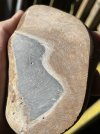
Today however I got another chance to get out and found an even more promising piece of chert. It’s very large, and so dense that it’s translucent.

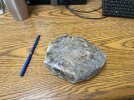
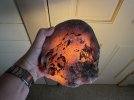
This is a strong indicator that the interior will be very uniform, fine grained, and inclusion free.
Wish me luck!


Today however I got another chance to get out and found an even more promising piece of chert. It’s very large, and so dense that it’s translucent.



This is a strong indicator that the interior will be very uniform, fine grained, and inclusion free.
Wish me luck!
SwissHeritageCo
Knifemaker / Craftsman / Service Provider
- Joined
- Jan 8, 2021
- Messages
- 3,428
Really interesting thread, great topic!
Makes me wonder how they flattened stones back in the days before power tools.
Makes me wonder how they flattened stones back in the days before power tools.
- Joined
- May 29, 2004
- Messages
- 3,018
Hi folks - I’m just adding a cross-reference to a related post where I discuss the big piece of chert in the picture above.
 www.bladeforums.com
Cheers,
www.bladeforums.com
Cheers,
Scdub
Razor Rock
Hi All, A few weeks ago I posted some pictures in an old thread of a large chert rock I found that I was hoping I could make into a straight-razor finishing stone. Thread 'Rocks' https://www.bladeforums.com/threads/rocks.1859813/ Well, after many hours of work, I finally got it essentially...
 www.bladeforums.com
www.bladeforums.com
Scdub
- Joined
- May 29, 2004
- Messages
- 3,018
Hi All,
A few weeks ago I found another amazing rock at New Brighton State Beach in Capitola, CA, while I was taking my Entrek for a walk.
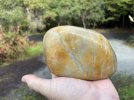
I happened to document the find as I’d been taking pics to include in another thread - linked here:
Anyway I just got a chance to work on it and it’s become one of my absolute best stones.
It had a naturally flat side so I was able to get it completely flat with less effort than usual. I used my 100, 400 and 1000 grit diamond wheels and just worked on it by hand.
As I was grinding I came across two small inclusions - one of them is pictured here:
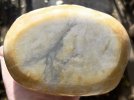

I got past it and stopped grinding - and ended up with an entirely “perfect” surface!
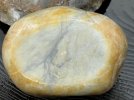
There are no inclusions and no hairline fractures - a first for me in a stone of this size.
This is now the second rock that I’ve found that’s suitable for use with my straight razor. Happily this has slightly larger grain size than my first razor stone, and at a 1000+ grit finish it removes steel much more aggressively. Now I have it as a “maintenance” stone and the big one as a finishing stone, so along with a hand made strop I can maintain my razor without using any store bought tools.



It’s not my “best” stone, (gonna be hard to beat my first razor stone) but it’s my favorite so far, and the last one I’d part with…
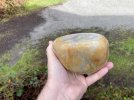
Cheers,
Scdub
A few weeks ago I found another amazing rock at New Brighton State Beach in Capitola, CA, while I was taking my Entrek for a walk.

I happened to document the find as I’d been taking pics to include in another thread - linked here:
Anyway I just got a chance to work on it and it’s become one of my absolute best stones.
It had a naturally flat side so I was able to get it completely flat with less effort than usual. I used my 100, 400 and 1000 grit diamond wheels and just worked on it by hand.
As I was grinding I came across two small inclusions - one of them is pictured here:


I got past it and stopped grinding - and ended up with an entirely “perfect” surface!

There are no inclusions and no hairline fractures - a first for me in a stone of this size.
This is now the second rock that I’ve found that’s suitable for use with my straight razor. Happily this has slightly larger grain size than my first razor stone, and at a 1000+ grit finish it removes steel much more aggressively. Now I have it as a “maintenance” stone and the big one as a finishing stone, so along with a hand made strop I can maintain my razor without using any store bought tools.



It’s not my “best” stone, (gonna be hard to beat my first razor stone) but it’s my favorite so far, and the last one I’d part with…

Cheers,
Scdub
